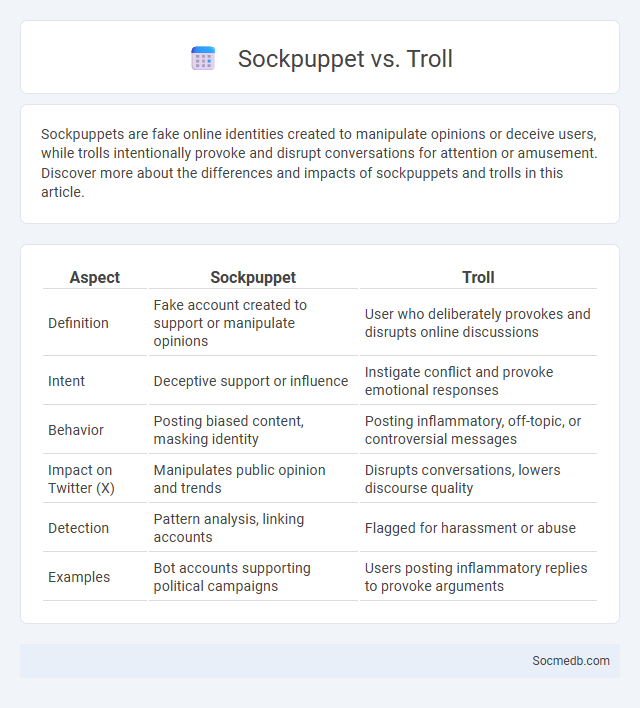
Photo illustration: Sockpuppet vs Troll
Sockpuppets are fake online identities created to manipulate opinions or deceive users, while trolls intentionally provoke and disrupt conversations for attention or amusement. Discover more about the differences and impacts of sockpuppets and trolls in this article.
Table of Comparison
| Aspect | Sockpuppet | Troll |
|---|---|---|
| Definition | Fake account created to support or manipulate opinions | User who deliberately provokes and disrupts online discussions |
| Intent | Deceptive support or influence | Instigate conflict and provoke emotional responses |
| Behavior | Posting biased content, masking identity | Posting inflammatory, off-topic, or controversial messages |
| Impact on Twitter (X) | Manipulates public opinion and trends | Disrupts conversations, lowers discourse quality |
| Detection | Pattern analysis, linking accounts | Flagged for harassment or abuse |
| Examples | Bot accounts supporting political campaigns | Users posting inflammatory replies to provoke arguments |
Understanding Online Deception: Sockpuppets and Trolls
Sockpuppets and trolls manipulate social media platforms by creating false identities to deceive users and disrupt genuine conversations. Understanding these online deceptions helps you recognize misleading content and protect your digital interactions from manipulation. This awareness enhances your ability to engage safely and critically with social media communities.
What is a Sockpuppet? Definition and Purpose
A sockpuppet is a fake online identity created by an individual to manipulate opinions, deceive others, or amplify a particular viewpoint on social media platforms. These accounts often interact with real users and other fake profiles to create the illusion of widespread support or agreement. Understanding sockpuppets is crucial to protecting your online reputation and maintaining authentic social interactions.
Identifying Trolls: Traits and Behaviors
Trolls on social media often exhibit traits such as posting inflammatory content, using provocative language, and consistently disrupting conversations to provoke emotional responses. Their behaviors include frequent off-topic comments, repeated harassment or personal attacks, and a pattern of targeting specific individuals or groups to incite conflict. Detecting these patterns helps platforms maintain healthy online communities by mitigating the impact of trolling.
Sockpuppet vs Troll: Key Differences
Sockpuppets are fake online identities created to manipulate opinions or create false support, often controlled by a single individual to amplify their influence subtly. Trolls provoke and incite emotional responses through inflammatory, off-topic, or disruptive comments designed to anger or upset others in online communities. Unlike troll behavior that thrives on confrontation and chaos, sockpuppetry aims at covert persuasion and deceit to shape narratives or public perception.
Motivations Behind Sockpuppetry
Sockpuppetry on social media often stems from the desire to manipulate public opinion, amplify support for a particular agenda, or evade accountability. Users create multiple identities to create the illusion of widespread endorsement or to harass and mislead others without risking personal repercussions. Understanding your motivations for engaging in or identifying sockpuppetry can help maintain authentic and trustworthy online interactions.
Techniques Trolls Use to Provoke
Trolls employ techniques such as posting inflammatory comments and spreading disinformation to provoke emotional reactions from social media users. They often exploit controversial topics and use anonymity to evade accountability while amplifying divisive content across platforms like Twitter, Facebook, and Reddit. These tactics disrupt online communities, diminish constructive dialogue, and increase polarization in digital environments.
Detecting Sockpuppets in Online Communities
Detecting sockpuppets in online communities involves analyzing patterns of behavior, linguistic styles, and IP addresses to identify multiple accounts controlled by a single individual. Advanced algorithms utilizing machine learning can detect anomalies and repetitive activity indicative of coordinated efforts to manipulate discussions or inflate influence. Ensuring robust sockpuppet detection enhances the integrity and trustworthiness of social media platforms.
The Impact of Trolls and Sockpuppets on Digital Discourse
Trolls and sockpuppets severely distort digital discourse by spreading misinformation, inciting conflict, and manipulating public opinion on social media platforms. Their coordinated activities erode trust, hinder constructive conversations, and skew algorithms that shape what You see online. Understanding these tactics is crucial for fostering authentic engagement and safeguarding the integrity of your digital environment.
Strategies to Combat Trolls and Sockpuppets
Effective strategies to combat trolls and sockpuppets include implementing robust moderation tools powered by AI to detect and block malicious accounts swiftly. You should encourage community reporting and establish clear guidelines to create a transparent environment that deters disruptive behavior. Leveraging behavioral analytics helps identify suspicious patterns and protect your social media platforms from coordinated attacks.
Building Healthy Online Engagement: Best Practices
Building healthy online engagement involves fostering respectful interactions, promoting authentic content, and encouraging diverse perspectives to create a positive social media environment. Implementing clear community guidelines and proactively moderating discussions reduces harmful behaviors such as trolling, misinformation, and cyberbullying. Leveraging data analytics helps identify engagement patterns, enabling targeted strategies that enhance user experience and sustained participation.
 socmedb.com
socmedb.com